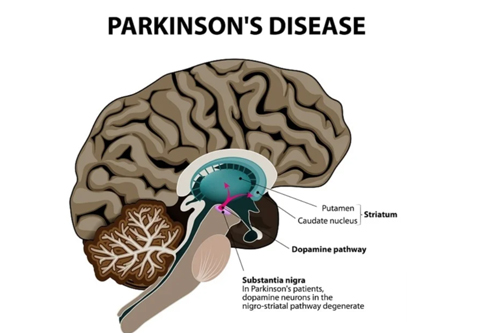
Parkinson's disease
In Nagpur, Parkinson’s disease is a progressive neurological disorder that gradually impairs various bodily functions. It often begins subtly, with a slight tremor in one hand. However, stiffness and slowed movements are more prevalent than tremors.
Early signs include reduced facial expressiveness, diminished arm swing during walking, and softer or slurred speech. As the disease advances, these symptoms intensify. While there is no cure for Parkinson’s disease, medications can help manage the symptoms. In certain cases, surgical interventions targeting specific brain regions are considered to alleviate some symptoms.
Historical Overview
The first detailed description of Parkinson’s disease was provided by Dr. James Parkinson in 1817 in his work “An Essay on the Shaking Palsy.” He meticulously documented the symptoms and progression of the condition, which later bore his name. Since then, significant advancements have been made in understanding the disease’s pathology, diagnosis, and treatment.
Epidemiology
Parkinson’s disease affects approximately 1% of the population over the age of 60, making it the second most common neurodegenerative disorder after Alzheimer’s disease. The prevalence increases with age, and men are slightly more affected than women. While PD is a global concern, its incidence varies across different regions and ethnic groups.
Pathophysiology
The primary pathological feature of Parkinson’s disease is the loss of dopaminergic neurons in the substantia nigra, a region of the midbrain. This neuronal loss leads to a significant reduction in dopamine levels, disrupting the balance of neurotransmitters and impairing motor control. Additionally, the presence of Lewy bodies—abnormal protein aggregates—within neurons is a hallmark of PD.
Causes and Risk Factors
- Genetic Factors: Mutations in specific genes, such as SNCA, LRRK2, and PARK2, have been linked to familial forms of PD.
- Environmental Factors: Exposure to certain pesticides, herbicides, and heavy metals has been associated with an increased risk of PD.
- Age: Advancing age is most significant risk factor.
- Gender: Males are higher risk than females.
- Family History: Having a close relative with PD increases one’s risk.
Clinical Manifestations
- Tremor: Resting tremor, often starting in one hand.
- Rigidity: Muscle stiffness and resistance to movement.
- Bradykinesia: Slowness of movement, making daily tasks challenging.
- Postural Instability: Impaired balance and coordination, leading to falls.
- Cognitive Impairment: Memory problems and slowed thinking.
- Mood Disorders: Depression and anxiety.
- Sleep Disturbances: Insomnia and REM sleep behavior disorder.
- Autonomic Dysfunction: Constipation, urinary issues, and blood pressure fluctuations.
Treatment Approaches
1. Pharmacological Treatments
Medications play a central role in managing Parkinson’s disease by addressing the dopamine deficiency in the brain. Key pharmacological treatments include:
Levodopa: Considered the most effective treatment, levodopa is a precursor to dopamine that replenishes the brain’s diminishing supply. It’s often combined with carbidopa to prevent peripheral metabolism, thereby reducing side effects like nausea and vomiting.
Dopamine Agonists: These mimic dopamine’s effects in brain and can be used alone or with levodopa. They may have a longer duration of action but can cause side effects such as hallucinations, swelling, and sleepiness.
MAO-B Inhibitors: Monoamine oxidase-B inhibitors, like selegiline and rasagiline, prevent the breakdown of brain dopamine, thereby extending its action.
COMT Inhibitors: Catechol-O-methyltransferase inhibitors, such as entacapone, prolong the effect of levodopa by blocking its breakdown.
Amantadine: Originally an antiviral medication, amantadine can help reduce motor symptoms and dyskinesia associated with long-term levodopa use.
2. Surgical Interventions
For individuals with advanced Parkinson’s disease who no longer respond adequately to medications, surgical options may be considered:
Deep Brain Stimulation (DBS): This involves implanting electrodes into specific brain regions to modulate abnormal neural activity. DBS can significantly reduce motor symptoms and medication requirements.
Lesioning Procedures: Techniques like pallidotomy and thalamotomy involve creating small lesions in targeted brain areas to alleviate symptoms. However, these are less commonly performed due to the success of DBS.
Rehabilitation and Supportive Therapies
A multidisciplinary approach is beneficial in managing Parkinson’s disease:
Physical Therapy: Focuses on improving mobility, balance, and flexibility through exercises and movement strategies.
Occupational Therapy: Assists patients in maintaining independence by adapting daily activities and environments.
Speech Therapy: Addresses speech and swallowing difficulties, enhancing communication and reducing aspiration risks.
Exercise: Regular physical activity, such as aerobic exercises, has been shown to improve motor function and may slow disease progression.
Lifestyle Modifications
Incorporating certain lifestyle changes can help manage symptoms:
Diet: A balanced diet rich in fiber and fluids can alleviate constipation. Timing protein intake may also optimize medication efficacy.
Sleep Hygiene: Establishing regular sleep routines can address sleep disturbances common in PD.
Emerging Treatments and Research
A multidisciplinary approach is beneficial in managing Parkinson’s disease:
- Gene Therapy: Investigating the potential to modify genes associated with PD to slow disease progression.
- Stem Cell Therapy: Exploring the use of stem cells to replace damaged neurons in the brain.
- Novel Medications: Development of new drugs targeting different pathways involved in PD is underway.Contact Us
Conclusion
In Nagpur, individuals diagnosed with Parkinson’s disease have access to a range of medical professionals and support services dedicated to managing this progressive neurological disorder. Collaborative care involving neurologists, physiotherapists, and support groups is essential for enhancing patients’ quality of life.Schedule your Consultation with Dr. Ritesh Nawkhare
